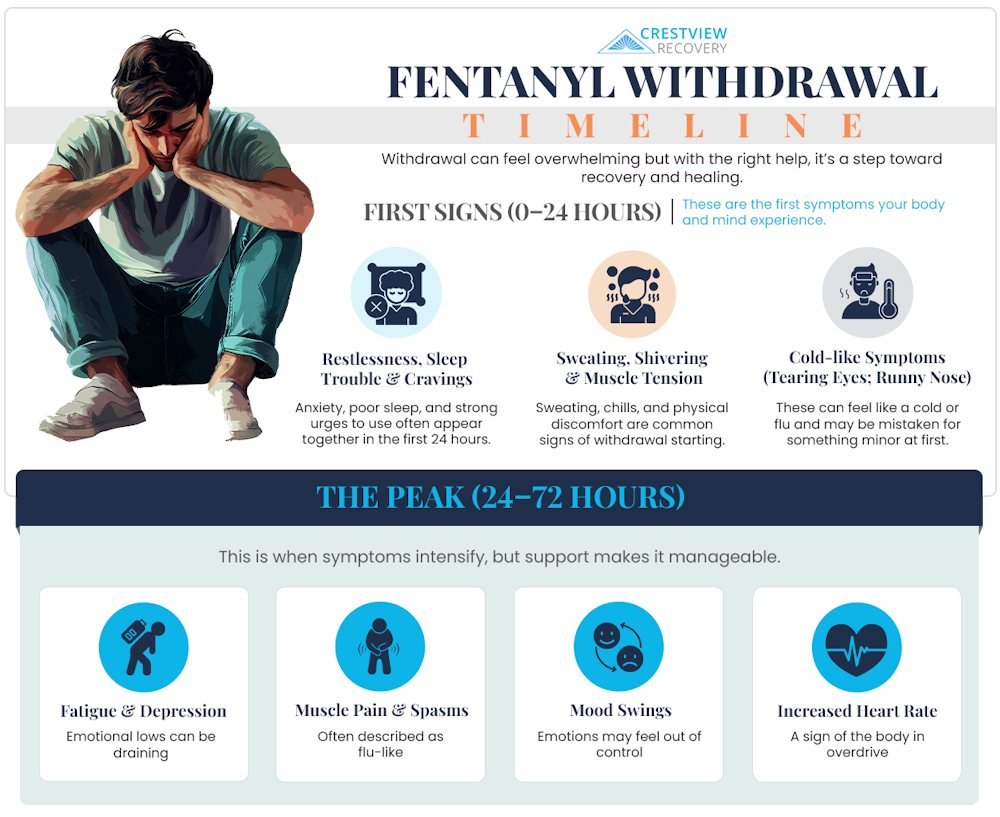In this guide, we will explore fentanyl symptoms, withdrawal, and available treatments, providing comprehensive insight into addressing fentanyl addiction.

Healing Begins Here
What Is Fentanyl?
Due to its strength, fentanyl’s potency leads to its prescription for various medical needs. It is commonly used during surgical procedures to induce anesthesia or control post-operative pain. Additionally, fentanyl patches are prescribed for chronic pain conditions, such as cancer-related pain or severe back pain, when around-the-clock pain relief is needed. Fentanyl may also be administered via injection or IV for acute pain management, such as during labor or in emergencies.
Despite its effectiveness in managing pain, fentanyl carries a high risk of misuse, addiction, and overdose. It is crucial for healthcare providers to carefully evaluate each patient’s medical history and pain management needs before prescribing fentanyl. Patients should be closely monitored while using fentanyl to ensure that they are using it safely and effectively. Additionally, healthcare professionals should educate patients and their caregivers about the risks associated with fentanyl. They should inform patients of the proper usage, storage, and disposal of the medication to minimize the potential for harm.

What Are The Fentanyl Withdrawal Symptoms?
- Flu-like symptoms: This might include nausea, vomiting, diarrhea, sweating, and chills.
- Muscle and bone pain: Individuals may experience achiness, cramps, and overall discomfort in their muscles and bones.
- Insomnia: Difficulty falling asleep or staying asleep is common during withdrawal.
- Anxiety and agitation: Feelings of restlessness, irritability, and anxiety can be prevalent.
- Mood swings: Emotional instability, including depression and sudden mood changes, can occur.
- Yawning and teary eyes: These are often early signs of opioid withdrawal.
- Increased heart rate and blood pressure: Withdrawal can lead to physiological changes like elevated heart rate and blood pressure.
These symptoms can be very uncomfortable and may lead individuals to continue using fentanyl to avoid them, thus perpetuating the cycle of dependence.
Why Do People Experience Fentanyl Withdrawal Symptoms?
When someone stops using fentanyl abruptly or reduces their dosage significantly, the body’s natural pain-relieving system is disrupted. This leads to the onset of withdrawal symptoms as the body struggles to regain balance without the presence of the drug. The fentanyl withdrawal timeline can vary from person to person, but symptoms typically start within a few hours to a day after the last dose and peak within 2-3 days. However, symptoms can persist for weeks or even months, depending on factors such as the individual’s metabolism, duration of fentanyl use, and dosage.
Withdrawal from fentanyl can be physically and emotionally challenging, and it often requires medical supervision and support to manage symptoms safely.


FENTANYL WITHDRAWAL TIMELINE
As time progresses, withdrawal symptoms peak within 2–3 days. During this peak period, individuals often endure intense physical discomfort, resembling flu-like symptoms such as nausea, vomiting, diarrhea, sweating, and chills. They may also confront severe muscle and bone pain, insomnia, anxiety, agitation, mood swings, and elevated heart rate and blood pressure. These symptoms can be distressing and difficult to manage without medical intervention.
Although the acute phase of fentanyl withdrawal usually lasts about a week, some symptoms may persist for weeks or even months, especially psychological issues like anxiety disorder and depression. Various factors, including the duration of fentanyl use, dosage, individual metabolism, and overall health, influence the duration and severity of withdrawal symptoms. Seeking medical support and supervision is crucial during the withdrawal process to ensure safety and provide effective symptom management.
HOW IS FENTANYL WITHDRAWAL TREATED?
Various medications may be prescribed to alleviate specific withdrawal symptoms. For example, anti-nausea medications can help with gastrointestinal distress, while sleep aids may be prescribed to address insomnia. Non-opioid pain relievers may also be used to manage muscle and bone pain.
Counseling and behavioral therapies are crucial components of fentanyl withdrawal treatment. Therapy sessions can help individuals address the underlying issues contributing to their substance use, develop coping strategies for managing cravings and triggers, and learn relapse prevention techniques.
In addition to medical and psychological interventions, supportive care is essential to provide a conducive environment for recovery. This may include nutritional support, hydration therapy, and access to social services and support groups.

WHAT IS FENTANYL DETOX?
During fentanyl detox, healthcare professionals may administer medications to help alleviate withdrawal symptoms such as nausea, vomiting, diarrhea, muscle aches, anxiety, and insomnia. These medications can include opioid agonists like methadone or buprenorphine. In addition, these drugs can help to reduce cravings and withdrawal discomfort without producing the intense euphoria of fentanyl. Other drugs may be used to manage specific symptoms or complications that arise during detox.
Overall, fentanyl detox is a critical component of addiction treatment. It helps individuals navigate the initial challenges of opioid withdrawal safely and prepares them for ongoing recovery efforts.
WHAT ARE THE MEDICATIONS TO EASE FENTANYL WITHDRAWAL?
- Methadone: It’s a long-acting opioid agonist that helps reduce withdrawal symptoms and cravings by stabilizing opioid receptors in the brain.
- Buprenorphine: This medication alleviates withdrawal, and cravings, with a ceiling effect on respiratory depression, and is safer than some opioids.
- Clonidine: Often used to manage symptoms like anxiety, agitation, muscle aches, sweating, and cramping associated with opioid withdrawal.
- Naltrexone: It’s an opioid antagonist that blocks the effects of opioids and can help prevent relapse once detoxification is complete.
- Naloxone: Primarily used as an emergency treatment for opioid overdose, naloxone can also be used in combination with other medications during detoxification to help manage withdrawal symptoms.
- Lofexidine: Specifically approved for opioid withdrawal, it works like clonidine, easing anxiety, agitation, and sweating symptoms during withdrawal.
- Antidepressants or anti-anxiety medications: These may be prescribed to manage mood-related symptoms that can occur during withdrawal.
Individuals undergoing fentanyl withdrawal should be under medical supervision, as withdrawal symptoms can be intense and potentially dangerous. A healthcare provider can tailor the medication regimen to meet the individual’s needs and monitor for complications. Additionally, counseling and support services are often crucial components of a comprehensive treatment plan for opioid withdrawal and addiction.

























